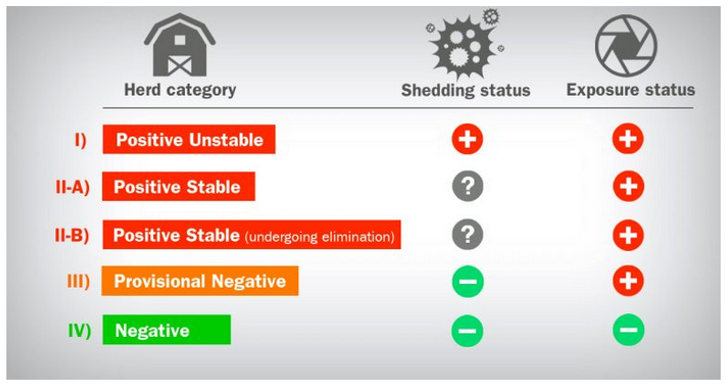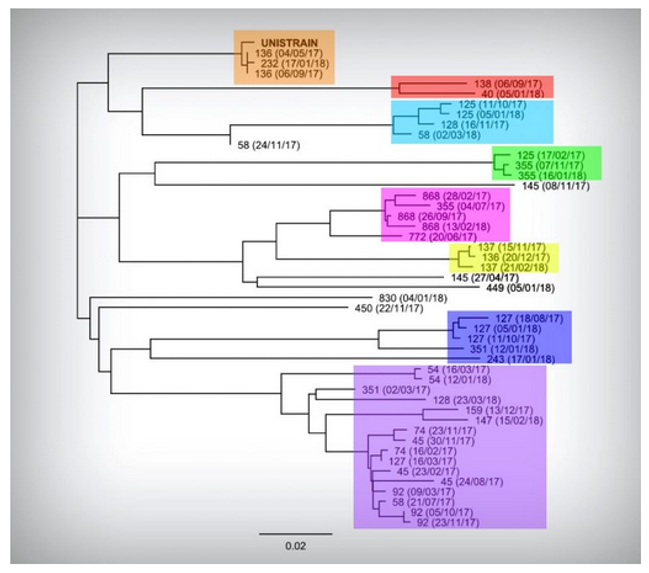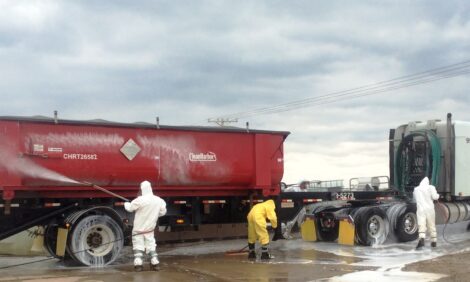



Analysing the impact of PRRS in a large pig production group in Europe
"Together against PRRS" is a global integrated service providing knowledge of PRRS in pig production companies.Introduction
Epidemiological knowledge of PRRS, not only at farm level, but also at regional level, is key to establishing control strategies for PRRS [1]. At regional level, although several PRRS diagnostic techniques are available, epidemiological knowledge of PRRS is limited because monitoring is normally used at farm level and with different criteria among farms. At farm level, generally speaking, routine and systematic PRRS diagnosis is not implemented as the focus is more on identifying PRRS in the case of an outbreak. The lack of systematic monitoring leads to irregular and non-standardised information about the PRRS status of farms, making it more difficult to understand how the virus flows within the farm and how to control it over time.
In order to provide a much better understanding of the disease, HIPRA has developed “Together against PRRS”, a programme which is a global integrated service for increasing knowledge of the PRRS situation in a company. “Together” comprises not only systematic PRRS monitoring, but also a biosecurity evaluation, the productive incidence for the disease and finally the economic impact of the disease.
Together against PRRS: a real case
Between February and March 2017, 40 breeding herds (35 PRRS positive and five PRRS negative, 85,600 sows in total), belonging to a large integrated pig production group in Spain, enrolled in a “Together against PRRS” programme for a year. The PRRS monitoring method is based on the AASV’s sampling protocol and herd classification system proposed by Holtkamp et al. [2]. This allows us to evaluate the epidemiological situation of PRRS over time.

All the positive farms adopted a monitoring protocol which consisted of monthly individual blood sampling of 30 due-to-wean piglets. Serum from individual blood samples was pooled (five pools of six samples) and tested by RT-PCR. Since no systematic PRRS diagnostic method had been implemented previously, all positive farms were assumed to be positive unstable. During the study period, farms reached positive stable status after four consecutive negative PCR tests for all tested pools and they lost it when at least one pool was PCR-positive, becoming positive unstable again. With the objective of describing the PRRSV genetic diversity amongst herds, selected PCR-positive results were submitted for PRRSV ORF5 nucleotide sequencing. A total of 13,650 piglets was sampled, 2,275 PCRs were performed and 47 PRRS strains were sequenced.
13 samplings per farm were performed during the one-year monitoring period on the 35 PRRSv positive farms. The percentage of positive stable farms increased from the beginning of the study until mid-July 2017 when it reached the maximum (74.3 percent). Afterwards, positive stable farms decreased until January 2018 when they reached the minimum (32.4 percent).

Sequencing
Sequencing is a very powerful tool for the identification of which strains are circulating on farms, allowing large companies to evaluate both the epidemiology and the biosecurity of their productive systems. For this reason, we sequenced 47 strains from 24 different farms and were able to identify eight different PRRSv clusters, whilst five sequences could not be related to any of these clusters. On ten farms, we were be able to sequence just one PRRSv strain and on 14 farms more than one was found. On those farms where more than one strain was obtained, recirculation events were observed on six farms (42 percent), lateral introduction of a new PRRSv strain on four farms (29 percent) and both events at the same time on four farms (29 percent). On two farms, the sequence matched the MLV vaccine used in sows. All this together indicates a highly dynamic PRRS circulation within farms in the group, frequently with both new PRRSv infections and recirculation. These findings indicate that PRRSv strain-sharing can often be found between farms in the same production group, indicating a significant epidemiologic relationship between them.

Sample references: farm code (sampling date). Groups of strains in the same colour box indicate a strong phylogenetic relationship (percent homology >95 percent)
Biosecurity
Biosecurity is one of the key factors for the prevention and control of PRRS. So assessment of a farm’s biosecurity through a systematic and complete survey should be included in every PRRS control programme. To this end, HIPRA has developed a PRRS biosecurity survey for breeding herds. This survey was specifically developed using information from papers previously published on the epidemiology of PRRSv. The biosecurity survey is based on aspects that are key for PRRS control. The number of questions included was simplified to 68: 23 questions refer to internal risk factors (management, immunisation and general characteristics that were weighted 33 percent) and 45 concern external risk (semen, replacement animals, transport, location and other measures that were weighted 67 percent). The weighting of each specific group of questions was validated by the knowledge and expertise of 15 PRRS experts.
35 PRRS positive farms enrolled in the “Together against PRRS” programme completed the survey in order to evaluate the association between PRRS status and PRRS risk scoring. The results of the survey showed that the total risk score in positive stable herds was statistically significantly lower (1482) than in positive unstable herds (1945). Moreover, the internal and external risk score was lower in positive stable herds than in positive unstable. In this case, there is a clear relation between higher risk scoring in the PRRS biosecurity survey and PRRS instability. In other words, those farms with worse biosecurity measures are more unstable to PRRS than those farms with better biosecurity measures. Biosecurity scoring provided by the PRRS biosecurity survey was useful for the assessment of vulnerabilities on biosecurity protocols in order to reduce the frequency of PRRS outbreaks and helped to prioritize investments in improving biosecurity practices over time.
Productivity
Veterinarians and producers have often asked us in different fora, or have even asked themselves, what the real impact of the PRRS virus is on their herds. For the first time in Europe, we have evaluated the real impact of the European PRRS strains in a multiple site production system.
For the evaluation of productive performance and its association with the PRRS status, weekly data from all PRRS-positive farms was collected throughout the entire monitoring period.
Abortions per 1,000 sows, born alive rate, pre-weaning mortality and weaned piglets per 1,000 sows were considered the key performance indicators.
Statistical differences were observed between positive unstable and positive stable in the born alive rate (+1.08 percent), pre-weaning mortality (-0.95 percent) and weaned piglets per 1,000 sows (+26.2 piglets). However, no statistical difference was observed regarding abortions per 1,000 sows [3]. This lack of difference in abortions could be explained by the classification system of PRRS status which was based on monitoring sampling instead of clinical diagnosis. Thus, possible peaks of abortions due to a new PRRSV circulation on positive stable farms may have not been associated with viraemia in suckling pigs, misclassifying farms as positive stable.
On the other hand, farms presented lower pre-weaning mortality and a higher born alive rate and weaned piglets per 1,000 sows during the periods of stability when compared with periods of instability, increasing the productive impact of PRRSV circulation in breeding herds. Taken on an annual basis, we could estimate a reduction of 1.36 weaned piglets/sow/year due to PRRS instability.
These results provide a better understanding of the productive impact of PRRSv on breeding farms, emphasising the efforts to stabilise and keep the PRRS-positive farms stable, especially in high-density swine production areas where elimination of the PRRS virus is costly and there is a low risk of long-term success.
Economic impact
Estimating the economic impact of the productive increase due to the achievement of PRRS stability in breeding herds can provide key information for the assessment of the cost-benefit of the implementation of PRRS control programmes and strategies. The final step of the “Together against PRRS” programme was to evaluate the economic benefits of achieving PRRS stable status in those PRRS unstable breeding herds. After analysing productivity, a difference of 26.2 weaned piglets per 1000 sows was estimated between PRRS stable and PRRS unstable. Based on this difference, and using a partial-budgeting model, we estimated the total economic benefit of one-year PRRS stability achievement in this company.
For this, firstly, an increase in one-year weaned pigs in the company was estimated by adding the increase in weaned piglets per farm, taking into account the increase in stable weeks and sow population on each farm (Total increase of 70,048 weaned pigs). Next, the increase in pigs-to-market was estimated by applying a 6 percent wean-to-finish mortality rate, according to the average wean-to-finish mortality rate reported in the company (Total increase of 65,845 pigs to market).
Finally, the economic benefit due to PRRS stability achievement was calculated taking into account the average market price in Spain (1.25€) [4] and the company’s estimated production (0.95€ per Kg of live pig) and the average pig’s live bodyweight at market (107Kg). We estimated an economic benefit of 2.1 M€ due to achievement of PRRS stability [5]. Despite the fact that a more accurate estimation of economic benefits can be performed using more complex models including multiple factors, these easily obtained gross estimations can provide reliable and valuable indicators to increase the awareness of managers and workers of the benefits that they can obtain by investment in PRRS control measures.
Conclusions
In conclusion, through the “Together against PRRS” programme, for the first time in Europe we have established the basis for knowledge of PRRS epidemiology and have provided key data for PRRS status classification in one of the largest pig producers in Europe. Moreover, PRRSv sequencing should be included in any PRRS control programme as a systematic tool for a better understanding of the PRRSv epidemiology between farms of the same company or region. Analyzing the impact of PRRS on productivity reinforcing efforts to stabilise and keep the PRRS-positive farms PRRS stable. And last but not least, estimating the economic benefit of PRRS stability is a key point to consider in the design of control strategies and the evaluation of the return on investment of the actions implemented to stabilise breeding herds such as biosecurity reinforcement measures and vaccination of breeders.
A global approach of the disease including monitoring, biosecurity, sequencing, evaluation of the impact on productivity and return of the investment of the applied measures it’s exactly what “Together against PRRS” offers.







